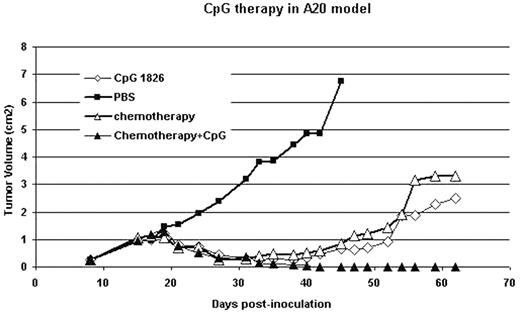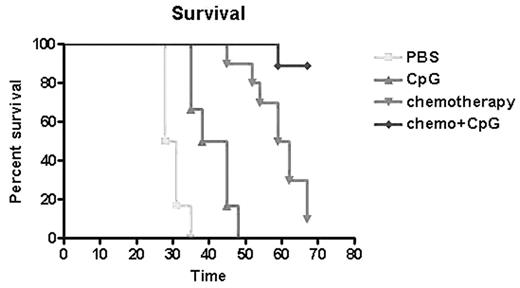Abstract
Unmethylated cytosine-phosphorothioate-guanine nucleotides (CpG) are immuostimulators that can activate both innate and adaptive immunity. By binding to its receptor, TLR9, CpG can activate dendritic cells and B cells by inducing the secretion of cytokines, and increasing the expression of costimulatory molecules, such as CD80 and CD86. In this study, a B type CpG, CpG1826, was given intratumorally in an A20 lymphoma animal model. CpG alone can delay the growth of tumor in this model, however, the majority of the treated tumor-bearing mice still die, and it has very little effect on systemic tumor cells. Here we propose a new therapeutic strategy, a combination of cyclophosphomide (CTX), followed by subsequent intratumoral injection of CpG. BALB/c mice were inoculated s.c. with 107 A20 cells in the lower back, and treatment started on day 17 when tumor reached approximately 1.0 cm in diameter. CTX (100mg/Kg) was given i.p. on day 17 and 18, and for the groups that received CpG, CpG was injected intratumorally on day 19,20,21,24, and 26 with 100μg/dose. As shown in Fig.1, the combination of CTX with CpG could cure well-established large size (>1.2cm in diameter) tumor, and mice remained tumor-free 5–6 months after the initial treatment. Conversely, the majority of mice that received CTX or CpG alone died of lymphoma. Tumor-free mice from this combined maneuver are protected from a lethal dose of A20 challenge even 5 months after the initial treatment. Our studies also showed that this combination is site dependent, as CTX combined with intratumoral injection of CpG had a much better therapeutic effect (100% survival), as compared to injection of CpG into a distant normal site (20% survival). Our studies also indicated that this combined maneuver is CD8+T cell dependent, as no therapeutic effect was observed when we repeated this experiment in a CD8+ T cell knockout model. We also demonstrated the systemic effect of this combination strategy in mice bearing tumors at two different sites. In combination with CTX, injection of one site with CpG controlled the growth of the second site tumor as opposed to a transient effect from chemotherapy or CpG alone. This led to significant prolongation of overall survival (Fig.2). In summary, we have shown that this combined chemoimmunotherapy strategy can cure both local and systemic tumor, which may provide a powerful antitumor therapy in the clinic.
Author notes
Corresponding author



This feature is available to Subscribers Only
Sign In or Create an Account Close Modal